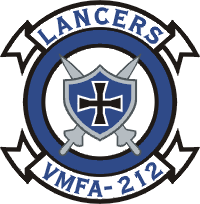
Marine Fighter Attack Squadron 212 (VMFA-212) was a United States Marine Corps F/A-18 Hornet squadron. Most recently known as the "Lancers", the squadron was last based at Marine Corps Air Station Iwakuni, Japan and fell under the command of Marine Aircraft Group 12 (MAG-12) and the 1st Marine Aircraft Wing. Due to a re-organization within Marine aviation, the squadron was deactivated in 2008. It is scheduled to be reactivated as an MV-22B squadron in 2019 under MAG 26 at MCAS New River, NC.

The New Georgia campaign was a series of land and naval battles of the Pacific campaign of World War II between Allied forces and the Empire of Japan. It was part of Operation Cartwheel, the Allied strategy in the South Pacific to isolate the Japanese base around Rabaul. The campaign took place in the New Georgia group of islands, in the central Solomon Islands and followed the Allied capture of the Russell Islands. The main fighting took place on New Georgia island itself, although significant actions also took place around the island chain throughout the campaign.

Vella Lavella is an island in the Western Province of the Solomon Islands. It lies to the west of New Georgia, but is considered one of the New Georgia Group. To its west are the Treasury Islands.

Baa Baa Black Sheep is an American television series that aired on NBC from September 23, 1976, until April 6, 1978. It was part period military drama, part comedy. In the final seven episodes, the character list was revamped, dropping some squadron pilots, adding a 16-year-old pilot and four nurses.

The Battle of the Treasury Islands was a Second World War battle that took place between 27 October and 12 November 1943 on the Treasury Islands group, part of the Solomon Islands. The battle formed part of the wider Pacific War and involved New Zealand and US forces fighting against Japanese troops. The majority of the ground forces were provided by the New Zealand 3rd Division.
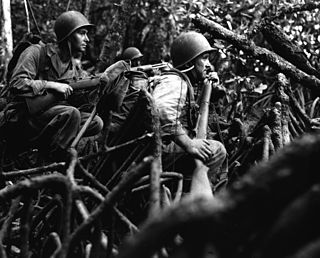
The Battle of Vella Lavella was fought from 15 August – 6 October 1943 between Japan and the Allied forces from New Zealand and the United States at the end of the New Georgia campaign. Vella Lavella, an island located in the Solomon Islands, had been occupied by Japanese forces early during the war in the Pacific. Following the fighting around Munda Point, the Allies recaptured the island in late 1943, following a decision to bypass a large concentration of Japanese troops on the island of Kolombangara.
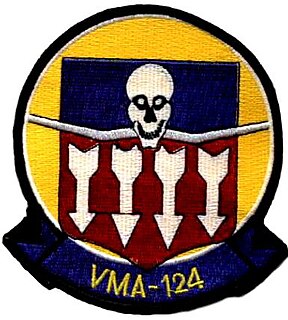
Marine Fighter Attack Squadron 124 (VMFA-124) was a flying squadron in the Marine Forces Reserve based out of Naval Air Station Memphis flying the A-4 Skyhawk. They were part of Marine Aircraft Group 42 and were decommissioned on 19 June 1999. The squadron was the first Marine squadron to fly the F4U Corsair during World War II and also one of the first Marine squadrons to be based on an aircraft carrier. They were known as the “Wild Aces” and ended World War II with 78 air-to-air victories against Japanese aircraft.
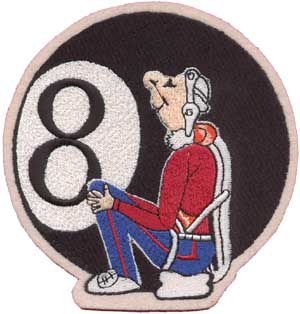
Marine Fighter Squadron 123 (VMF-123) was a fighter squadron of the United States Marine Corps during World War II and in the Marine Forces Reserve. Known as the “Flying Eight Balls,” they fought on Guadalcanal, Iwo Jima, and Okinawa and served as a training squadron for replacement pilots during the Korean War. They were deactivated in the late 1950s and remain in an inactive status today.

Nissan Island Airport is an airfield serving Nissan Island, in the Autonomous Region of Bougainville in Papua New Guinea. It resides at an elevation of 100 feet (30 m) above mean sea level and has a 1,200-metre (3,937 ft) runway designated 14/32.
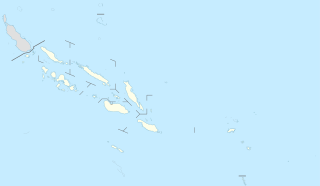
Yandina Airport is an airport on Mbanika in the Solomon Islands.

Marine Fighting Squadron 215 (VMF-215) was a fighter squadron of the United States Marine Corps that was commissioned and fought during World War II. Known as "The Fighting Corsairs", the squadron fought in many areas of the Pacific War, including the Battle of Bougainville. During its four-and-a-half month tour, the squadron was credited with shooting down 137 enemy aircraft, fourth most in Marine Corps aviation history.

Marine Fighter Attack Squadron 124 (VMFA-124) was a flying squadron in the Marine Forces Reserve based out of Naval Air Station Memphis flying the A-4 Skyhawk. They were part of Marine Aircraft Group 42 and were decommissioned on 19 June 1999. The squadron is best known as the first Marine squadron to fly the F4U Corsair during World War II and also the first squadron to be based on an aircraft carrier. They were known as the “Wild Aces” and ended World War II with 78 air-to-air victories against Japanese aircraft.

Luganville Airfield or Bomber Field #3 is a former World War II airfield on the island of Espiritu Santo in the New Hebrides Islands at the Espiritu Santo Naval Base.
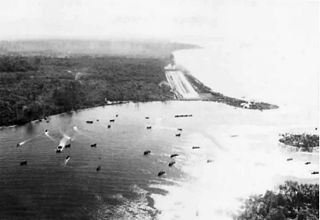
Torokina Airfield, also known as Cape Torokina Airfield, is a former World War II airfield located at Cape Torokina, Bougainville.

Turtle Bay Airfield or Fighter Field #1 is a former World War II airfield on the island of Espiritu Santo in the New Hebrides Islands at the Espiritu Santo Naval Base.

Nanumea Airfield is a former World War II airfield on the island of Nanumea in the Ellice Islands.
Piva Airfield is a former World War II airfield on Bougainville Island in the Solomon Islands archipelago.
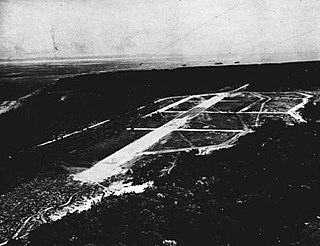
Kukum Field also known as Fighter 2 Airfield is a former World War II airfield on Guadalcanal, Solomon Islands.
Ondonga Airfield is a former World War II airfield on New Georgia in the Solomon Islands archipelago.

Segi Point Airfield is a former World War II airfield on New Georgia in the Solomon Islands archipelago.


















